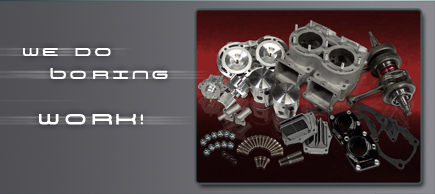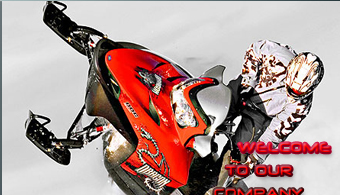|
|
Q
I have a 2 cylinder engine. Can I bore just one side?
|
A
YES. Boring one side is virtually undetectable. |
Q Will my
engine be out of balance if I have one oversize piston and one stock?
|
A
NO. Modern pistons, especially forged, are internally lightened to
compensate for the larger diameter. |
Q I heard
my engine will not be as reliable once I bore it. Is that true?
|
A
NO. It depends on two things:
Most important is who bores the cylinder and who finishes the
cylinder.
It also matters what kind of piston is used. Many people think a
piston is
a piston
and they buy the cheapest one they can find. |
Q Will my
engine run hotter once it is bored?
|
A
NO. Properly done it will run no hotter than stock. |
Q
Should I mix extra oil in the gas?
|
A
NO. Extra oil:
|
can cause the piston to run hotter during breakin.
can cause excess carbon to accumulate.
can cause the cylinder walls to glaze and the rings may
not seal properly if at all. |
|
Q
What is the difference between cast and forged pistons?
|
A
A cast piston is liquid molten aluminum poured or injected into a
mold. A forged piston
is made
from a solid ingot and pressed or extruded into shape before
machining. |
Q
What piston would you recommend? Why?
A A forged
piston, specifically a Wiseco.
|
1-
Cast pistons are brittle and often shatter causing catastrophic
engine
damage. Forged pistons are stronger to a much higher temperature
than a cast piston could endure.
2-
Forged pistons dissapate heat better and run cooler than cast
pistons.
3-
Forged pistons are a hi-silicon, low expansion aluminum alloy
with
improved cam and taper grind from computerized machining, that
controls expansion to allow tighter pistonto wall clearances.
This
increases piston stability and maximizes horsepower.
4- A
forged piston is also lighter than a cast piston because less
material
is needed to manufacture a strong and dependable forged piston.
|
|
|
 |
|
BREAK-IN PROCEDURES |
|
1- |
Start your engine and
let it idle, occasionally blipping the throttle for four to five
minutes. Allow the engine to cool completely. Repeat this heat cycle
process four more times. |
|
2- |
Warm up the engine
again and ride the bike five to seven minutes at a very easy
pace. Very the rpm, and do not ride at one speed. Do not ride at
more than 1/3 throttle or more than 1/3 rpm. Let the engine cool
down completely and repeat the initial break in ride. Let the engine
cool down. |
|
3- |
Check the base and
head nuts for proper torque. Check the coolant level and coolant
as necessary. |
|
4- |
Ride the bike for
five to ten minutes at a moderate pace. Very the rpm, and do not
ride at more than 3/4 throttle or more than 3/4 rpm. Then let the
engine cool completely and repeat this secondary break-in twice. |
|
5- |
Replace the spark
with a new one. Ride the bike for five to eight minutes at a
moderate pace. Vary the rpm, and shift up and down gears. Once the
engine is up to operating temperature, you can make a jetting pass.
Start in second gear and ride at full throttle at fourth gear, fully
revving out fourth gear. With the throttle wide open in fourth hold
the kill button down, pull the clutch and stop. This is called a
plug chop. |
|
6- |
Read the spark plug.
With a pocket flashlight and a magnifying glass, look at the
porcelain part of the plug only. As you view the plug from the
center electrode, look down on the length of the porcelain to its
base. There should be a dark chocolate colored smoke ring. There was
not sufficient time to thoroughly color the whole plug, so the nose
of the insulator may still be white. As long as there is a visible
dark ring at the base, everything is OK. Remember, we want break-in
jetting, so the plug should read rich/dark. Richen the jetting as
necessary. If you are having a hard time reading the spark plug,
follow the proceeding steps: Put the plug in a vice and hacksaw
around the plug at the washer. Break the threads off with vise grips
and the porcelain will be easy to read. |
|
7- |
Complete the break-in
by riding at an aggressive pace for fifteen minutes. Vary the
rpm and do not cruise at part throttle. Ride hard without revving
the engine too high. At the end of this final break-in session do
another jetting pass/plug chop as described above. Check the spark
plug for the correct dark/rich condition. Wiseco piston equipped
engines will require another one or two break-in cycles. If your
engine is equipped with a Wiseco piston, continue with the following
steps: Ride at a s recreational pace not revving the engine hard.
Full throttle should only be used for very short periods. Fifth and
sixth gears should only be used to cruise. Ride one tank of gas
through the engine in this manner to complete the break-in. |
|
8- |
Replace the spark
plug with a new one. Ride the bike aggressively for eight
minutes and do a jetting pass/plug chop in fifth gear. If the
porcelain is still dark/rich, lean the main jet size one at a time
until the smoke ring at the base of the porcelain is light brown. If
the porcelain base is white, do not run the engine and contact Bill
Bune Enterprises. If the plug color looks good, continue riding at a
race pace for ten minutes. Stop and let the engine cool. Check the
torque on the cylinder base and head nuts. |
|
9- |
More on jetting: If you generally
run your engine flat out sixth gear, then make your jet pass/plug
chop in sixth. Motocross jetting is checked in fifth gear, therefore
it is not safe to run MX jetting in the desert wide open in sixth.
Desert jetting is richer than MX jetting. When running an engine at
full throttle for extended periods, be sure to chop the throttle
decisively to slow down. Just rolling out a little can seize a
well-jetted engine.
|
|
Remember, the best top-end overhaul,
done by the most qualified mechanic,
is only as good as your break-in
procedure. Good luck! |
|
|
PISTON /
CYLINDER FAILURE CAUSES |
|
THE FOLLOWING LIST
CONTAINS A FEW OF THE PISTON AND/OR CYLINDER FAILURE CAUSES: |
|
|
1)
INSUFFICIENT OR IMPROPER BREAK-IN PROCEDURE.
2) Cold seizure ( insufficient warm-up)
3) Failure to properly wash and prelube piston and
cylinder prior to assembly.
4) Insufficient air speed through fins on air cooled
engines.
5) Improper ignition timing.
6) Carburetor jetting to lean.
7) Carburetor jetting too rich.
8) Gas and Oil not thoroughly mixed.
9) Excessive load on or lugging of the engine.
10) Worn out or improperly installed crank seals.
11) Blown head gasket.
12) Head gasket improperly installed.
13) Engine speed too high during break-in period.
14) Alteration of intake or exhaust system without rejetting.
15) Insufficient ring end gap.
16) Too much ring end gap.
17) Improper ring style or type.
18) Insufficient oil in gas.
19) Too much oil in gas.
20) Poor quality, cheap or wrong oil.
21) Too much compression.
22) Bad or old gas.
23) Gas with too low of an octane rating.
24) Addition of the wrong gasoline antifreeze in mixed gas.
25) Fuel additives improperly mixed or used.
26) Improper spark plug.
27) Insufficient piston to wall clearance.
28) Too much piston wall clearance.
29) Use of badly worn or distorted piston in fresh bore.
30) Pre-ignition.
31) Detonation.
32) Insufficient piston to squish band clearance.
33) Plugged or restricted exhaust system.
34) Air leaks around intake manifold, base gasket or center
gasket.
35) Use of a piston other than the one the cylinder was
originally sized to.
36) Honing too course.
37) No honing at all.
38) Head bolts overtorqued.
39) Faulty or stuck thermostat.
40) Thermostat removed from system.
41) Bad oil pump.
42) Bad water pump.
43) Improper cooling: low water level, fins clogged with mud.
44) Use of oxygenate gas without rejetting.
45) Carburetors not synchronized.
46) Loose fitting sleeve.
47) Cracked sleeve.
48) Ice in oil line.
49) Ice in fuel line.
50) Clogged, pinched or leaking fuel or oil line.
51) Cooling system not properly bled.
52) Oil injection system not properly bled.
53) Improperly installed fan shrouds.
54) Plugged jets.
55) Loose or broken fan belt.
56) Water in float bowl.
57) Dirt in float bowl.
58) Loose or missing drain plug.
59) Anti-freeze in combustion chamber; faulty head gasket or
cracks.
60) Insufficient fuel; may need two fuel pumps.
61) Leaking, loose or plugged fuel pump pulse line.
62) Bad fuel pump.
63) Loose, leaking or plugged pulse line.
64) Poor quality piston.
65) Clutch not properly set up.
66) Cracked fuel line in tank.
67) No snow on heat exchanger.
68) Diesel fuel in gas tank.
69) Improperly installed piston return spring.
70) Too much alcohol in driver.
71) By far the most common cause of piston and engine failure
comes from the loose nut that sits on
the seat and over revs the engine instead of shifting it and
generally doesn’t have an
understanding of what really makes it work or how to keep it
serviced.
|
|
|
CYLINDER PREPARATION
INSTRUCTIONS |
|
1- |
Wash with Soap & Water |
|
2- |
Oil |
|
3- |
Ring End Gap |
|
4- |
Timing |
|
5- |
Jetting |
| |
|
|
|
SLEEVING IS STILL THE SOLUTION... |
|
Re-sleeving
worn or seized motorcycle, snowmobile and watercraft cylinders,
continue to provide economical and available solutions to Riders
and Racers everywhere.
Cylinders sleeved with chrome-moly iron alloy sleeves can now be
bored to fit the many
over-sized pistons available on the market today. Pistons
available in oversize up to 2.50mm
provide the owner with a substantial economic incentive to
re-sleeve a worn cylinder. The cost
of a
bore job today is usually 10% of the cost of a new cylinder.
Combine that with the original
expense to re-sleeve a cylinder, usually about $200.00 (or 30%
to 40% lower than new cylinders),
the
owner realizes an overall savings that brings smiles to his or
her riding budget.
Two
stroke tuners and porting specialists find that when race
porting a sleeved cylinder they do not
have
to contend with flaking or peeling that they might with an
aluminum plated bore. Our 2.5mm thick
spun
cast-sleeves are made from an iron alloy of nickel, silicon and
hardened carbon chrome of which no plating process can compare.
To take it one step further Moly-2000 is added for a slick
anti-resistance to friction. This special ingredient reduces
ring drag to increase piston speed down the slick walls, giving
you great RPM. Racers and engine rebuilders have relied on these
features for fifty years. |
|
|
|
|
(763)427-6738
(763)576-9924
Please email us for any inquiries:
josh@billbune.com
|
|
|
|
|
|





